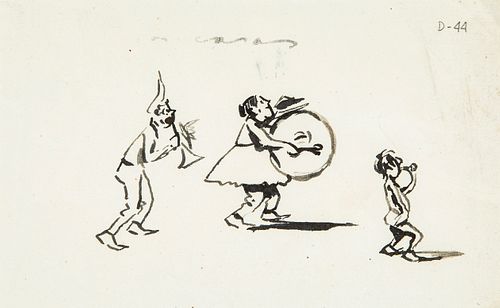RAMÓN CASAS CARBÓ (Barcelona, 1866 - 1932). Untitled. Ink on paper. Signed in the upper area.
Lot 16
About Seller
Setdart Auction House
Carrer Aragó 346
Barcelona
Spain
Setdart Subastas was born in 2004 and is currently the first online art auction in Spain with solidity, prestige and reliability guaranteed by our more than 60,000 users. Setdart has a young, dynamic and enterprising team ready to successfully manage the purchase and sale of art works through custom...Read more
Categories
Estimate:
EUR€1,500 - EUR€1,600
$1,578.95 - $1,684.21
Absentee vs Live bid
Two ways to bid:
- Leave a max absentee bid and the platform will bid on your behalf up to your maximum bid during the live auction.
- Bid live during the auction and your bids will be submitted real-time to the auctioneer.
Bid Increments
| Price | Bid Increment |
|---|---|
| EUR€0 | EUR€10 |
| EUR€200 | EUR€25 |
| EUR€500 | EUR€50 |
| EUR€1,000 | EUR€100 |
| EUR€3,000 | EUR€200 |
| EUR€5,000 | EUR€500 |
| EUR€10,000 | EUR€1,000 |
| EUR€20,000 | EUR€2,000 |
| EUR€50,000 | EUR€5,000 |
About Auction
By Setdart Auction House
Oct 27, 2021
Set Reminder
2021-10-27 10:00:00
2021-10-27 10:00:00
America/New_York
Bidsquare
Bidsquare : 19th & 20th Century Paintings & Decorative Arts
https://www.bidsquare.com/auctions/setdart-auction-house/19th-20th-century-paintings-decorative-arts-7767
Setdart Auction House sofia@setdart.com
Setdart Auction House sofia@setdart.com
- Lot Description
RAMÓN CASAS CARBÓ (Barcelona, 1866 - 1932). Untitled. Ink on paper. Signed in the upper area. Measurements: 12 x 19 cm; 33 x 40 cm (frame). As a procession, Casas, collects in this drawing three sketchy characters, who seem to be part of a musical procession. Each of the protagonists differs completely from the other. In addition, each one carries a different instrument. The rapid stroke and the configuration of the scene, added to the numbering found in the upper left zone (D-44), are characteristics that invite us to think that this is a work belonging to the artist's personal notebook. An outstanding painter and draftsman, Casas began painting as a disciple of Joan Vicens. In 1881 he made his first trip to Paris, where he completed his training at the Carolus Duran and Gervex academies. The following year he participated for the first time in an exhibition at the Sala Parés in Barcelona, and in 1883 he presented a self-portrait at the Salon des Champs Elysées in Paris, which earned him an invitation to become a member of the Salon de la Societé d'Artistes Françaises. He spent the following years traveling and painting between Paris, Barcelona, Madrid and Granada. In 1886, suffering from tuberculosis, he settled in Barcelona to recover. There he came into contact with Santiago Rusiñol, Eugène Carrière and Ignacio Zuloaga. After a trip through Catalonia with Rusiñol in 1889, Casas returned to Paris with his friend. The following year he took part in a group exhibition at the Sala Parés, together with Rusiñol and Clarasó, and in fact the three of them continued to hold joint exhibitions there until Rusiñol's death in 1931. His works at this time are halfway between academicism and French impressionism, in a sort of germ of what would later become Catalan modernism. His fame continued to spread throughout Europe, and he held successful exhibitions in Madrid and Berlin, as well as participating in the Chicago World's Fair of 1893. Casas settled permanently in Barcelona, immersed in the modernist environment, although he continued to travel to Paris for the annual salons. He financed the premises that would become a point of reference for the modernists, the café Els Quatre Gats, inaugurated in 1897. Two years later he organized his first individual exhibition at the Sala Parés. While his fame as a painter grew, Casas began to work as a graphic designer, adopting the Art Nouveau style that came to define Catalan Modernism. In the following years his successes followed: he presented two works at the Universal Exhibition in Paris in 1900, won a prize in Munich in 1901, several of his works were included in the permanent exhibition of the Círculo del Liceo, had several international exhibitions and, in 1904, won first prize at the General Exhibition in Madrid. He is represented in the Prado Museum, the National Museum of Art of Catalonia, the Reina Sofia National Museum, the Thyssen-Bornemisza Museum, the Museum of Montserrat, the Cau Ferrat in Sitges, the Camón Aznar Museum in Zaragoza and the Contemporary Art Museums of Barcelona and Seville, among many others.
- Shipping Info
-
In-house shipping available. Please inquire at admin@setdart.com.
-
- Buyer's Premium



 EUR
EUR CAD
CAD AUD
AUD GBP
GBP MXN
MXN HKD
HKD CNY
CNY MYR
MYR SEK
SEK SGD
SGD CHF
CHF THB
THB













